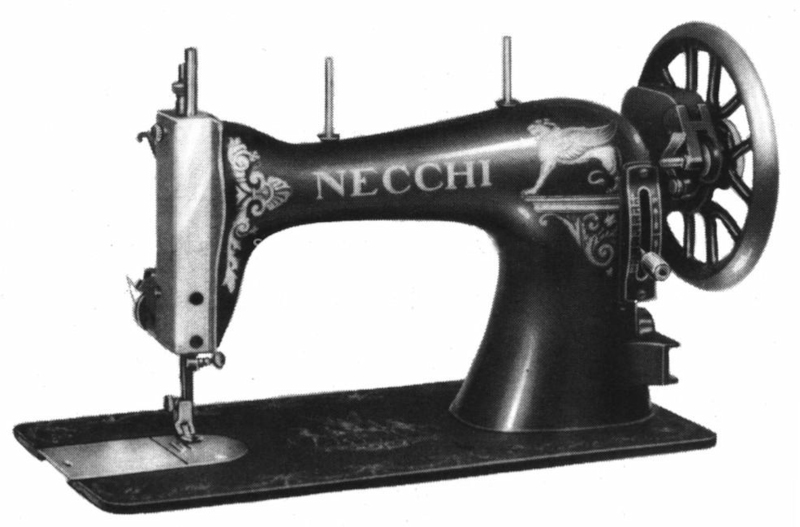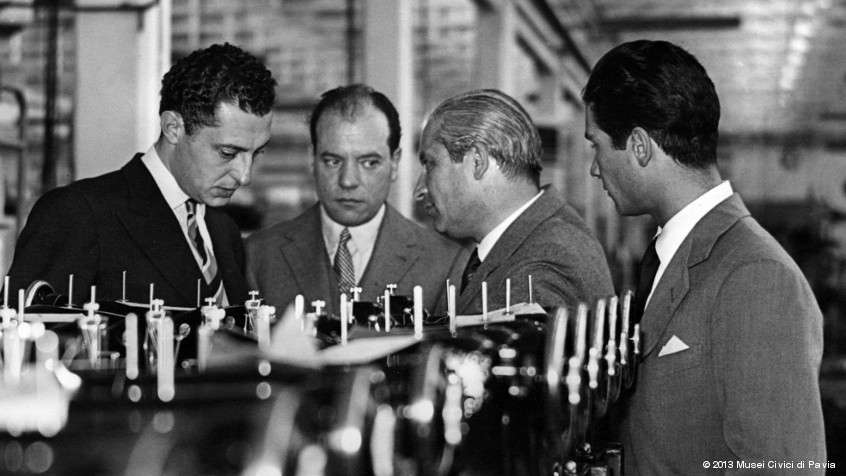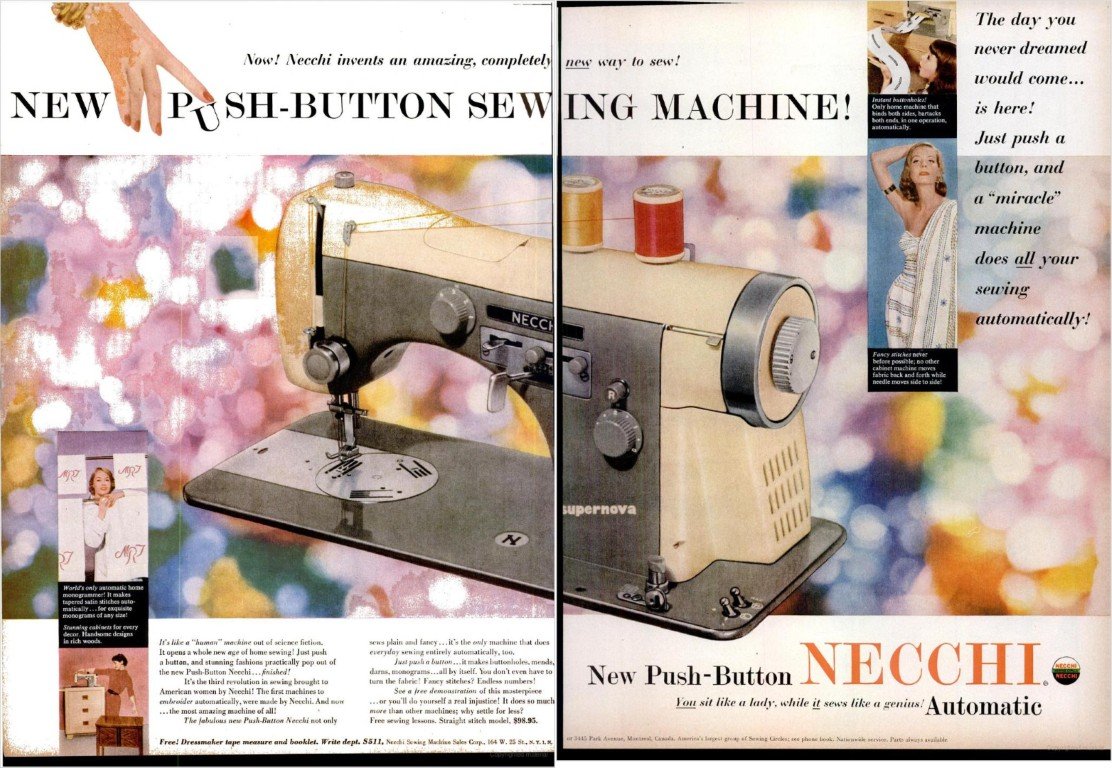When Vittorio Necchi's wife asked him for a sewing machine, Necchi wasn't content to just buy her one. The long-term results were some of the finest sewing machines of the all-metal era, award-winning designs, and considerable impact to the global market.
Italy's First Sewing Machine Manufacturer
 |
| An early 1920s Necchi. |
Following World War I, Vittorio Necchi realized his family's foundry business needed to seek a new direction to prosper in the changing business world. Necchi's official website tells us, "When his wife asked him to buy her a sewing machine, her only choices were imported models made in the U.S. and northern Europe. Vittorio had an idea: why not create Italy's first sewing machine company?"
Necchi released its first hand-operated sewing machine by 1924, producing about 2,000 machines per year.
 |
| A 1930s model Necchi. |
Success After World War II
 |
| Vittorio Necchi bred pheasants and cultivated orchids. |
By the 1940s, Necchi achieved international success by embracing an expanding distribution method that began in the 1920s: points of sale were created by independent entrepreneurs or "dealers" throughout the world.
 |
| Vittorio Necchi (third from left) meets with business associates in his factory in Pavia, Italy. |
Leon Jolson was one such dealer who made a huge impact on Necchi's U.S. presence. Jolson was a Polish Holocaust survivor who went from a destitute American immigrant to a wealthy entrepreneur within three short years of arriving in New York in 1947. After noticing that only basic sewing machines were prominent in New York's garment district, Jolson persisted in trying to convince Vittorio Necchi to license Necchi distribution to Jolson in the U.S. When Jolson personally met with Vittorio in Pavia, Italy, to share his vision for expanding Necchi into America, "the old man" - as Vittorio was called by many - agreed and within two weeks 10,000 orders were made.
Through Jolson, Necchi sold a model that offered dozens of cams (molded disks) that were inserted into the machine to create abundant stitches and embroidery patterns. This was unlike anything most Americans had seen, and it helped bolster a new "do it yourself" era among middle-class women, just in time for the prosperity of the post-war 1950s. The American housewife became aware of at-home sewing feats she didn't know were possible.
By 1947, Necchi produced 40% of the 120,000 machines made in Italy that year. By 1948, the company was producing 75,000 machines per year, distributed throughout the world. The factory in Pavia, Italy, integrated four production lines including the foundry, household and domestic sewing machines, and cabinet production.
 |
| Necchi introduced "Wonder Wheel" cam system in 1952. Many elaborate sewing tasks were possible without additional attachments. |
As Vittorio Necchi continued to advance his enterprise, the company benefited from the Marshall Plan, the post-war European Recovery Program in which the U.S. gave the modern-day equivalent of $100 billion as aid to Western Europe.
Necchi machines are featured in Still Stitching.
Award-Winning Modern Designs
Notable Necchi products included:
- 1948 - The Necchi Model BU with zigzag and numerous capabilities that did not require attachments.
- 1952 - The Wonder Wheel was a pattern disc that connected to the stitch width lever and was driven by the balance wheel to make decorative stitches.
 |
| 1955 magazine two-panel ad. |
- 1955 - The Automatic Supernova used drop-in cams and provided a round needle plate which rotated into three positions to support different stitch types.
- 1956 - The Mirella which offered a ground-breaking modern design. Necchi used the essential shape on additional subsequent models, such as the Lydia.
- 1958 - The Supernova Ultra, which Necchi claimed offered "technical and aesthetic advancement."
- 1961 - The Supernova Julia offered "Micro-Electro Control," providing power independent from the operator's controller - basically "automatic" sewing that would then switch off when a buttonhole or design was completed.
 |
| The stunning Mirella. |
Reorganization and renewed focus at Necchi in the early 1950s led to innovative and award winning design in 1954 for the BU Supernova series, and again in 1957 for the Mirella series. The Mirella was designed by renown Italian artist Marcello Nizzoli (1887-1969).
The Mirella was one of Nizzoli's two most famous designs, the other being a 1948 typewriter called the Olivetti Lexicon 80. Both of these objects are included in the Museum of Modern Art in New York.
| The smooth, rounded lines of the Lexicon 80 appeared nine years before the Necchi Mirella. Both were aesthetically designed by Marcello Nizzoli. |
The Slow Decline of the Necchi Company and the Death of Vittorio
 |
| Interior assembly-line of the Necchi factory. 1950. |
By the mid-1950s, Necchi was absolutely dominant in their domestic market, due largely to their sophisticated manufacturing methods. The company had implemented a true assembly-line. They had reduced the hours required to produce a sewing machine by more than 30%.
 |
| A 1959 sale advertisement. |
By 1960, the splendor showed signs of waning. The Italian domestic market was becoming saturated, and the Japanese manufacturers were gaining global influence. Vittorio was strongly opposed to manufacturing goods other than sewing machines in spite of his factory's strong capabilities, but in 1959 Necchi agreed to manufacturer refrigeration compressors in addition to Vittorio's beloved sewing machines.
The decision to manufacture compressors proved unfortunate in time. The compressor was the most expensive part of the refrigerator to produce, and as a mere contractor, Necchi never benefited from the generous profit margin of the entire refrigerator appliance. They were but a cog in a larger wheel, unlike their role in manufacturing sewing machines start to finish to reap the full reward of the final product.
But even sewing machines were a shrinking market for Necchi. Vittorio dipped into his own personal fortune to mitigate financial stress as the company tried returning to direct sales, a costly endeavor that meant more debt.
The Necchi dynasty ended when Vittorio died in November of 1975 following a long illness. He had no children, and his sisters had little interest in reviving the once-great enterprise. The company has been bought and sold multiple times, suffered, resurrected and moved.
The Pavia plants were closed and the land was parceled for residential reconstruction.
Epilogue: The Necchi Factory in Ruins - Pava, Italy





4 comments:
I still have one of these great all metal machines. Sews great.
I still have and still use, a Mirella which my mum bought from Harrods in 1957. It still works well.
I still have and still use a Mirella which my mother bought from Harrods in 1957.
I've just come into ownership of a beautiful, all original, deep green enameled BU Nova, which has sparked my interest in how it came to be.
Post a Comment